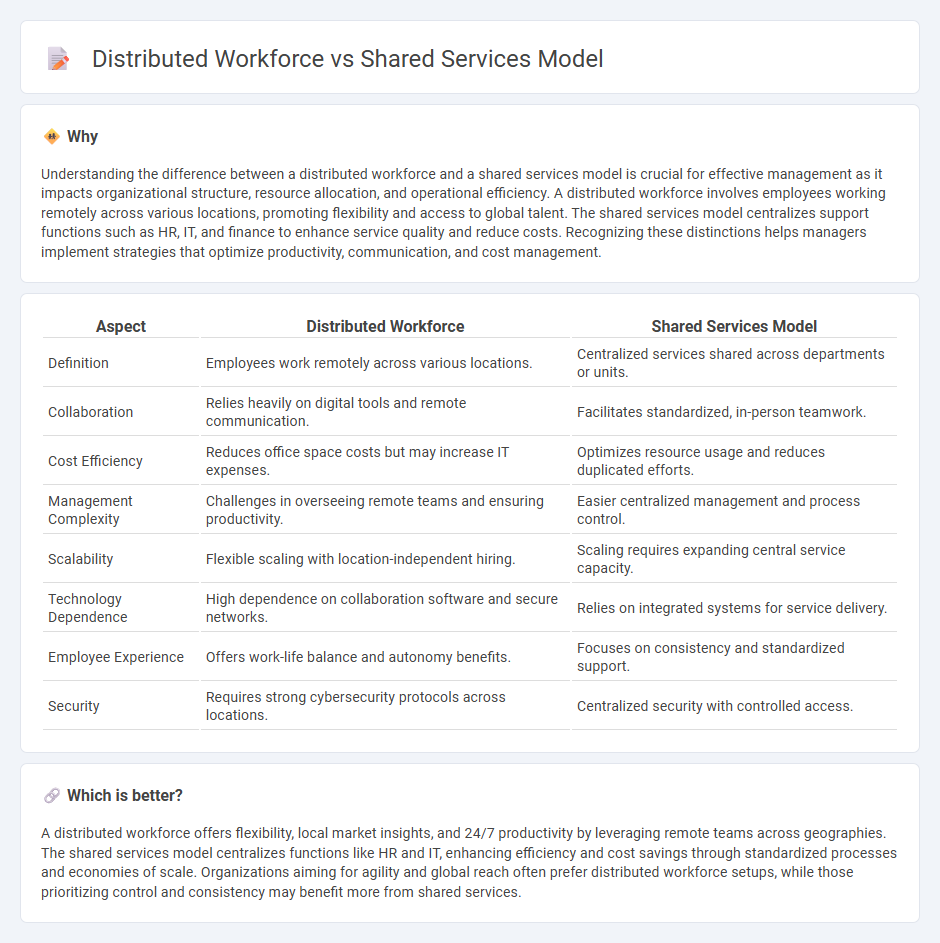
Distributed workforce allows organizations to leverage talent across multiple locations, enhancing flexibility and reducing operational costs. In contrast, the shared services model centralizes support functions like HR, IT, and finance to improve efficiency and standardize processes across business units. Explore the advantages and challenges of each approach to determine the best fit for your management strategy.
Why it is important
Understanding the difference between a distributed workforce and a shared services model is crucial for effective management as it impacts organizational structure, resource allocation, and operational efficiency. A distributed workforce involves employees working remotely across various locations, promoting flexibility and access to global talent. The shared services model centralizes support functions such as HR, IT, and finance to enhance service quality and reduce costs. Recognizing these distinctions helps managers implement strategies that optimize productivity, communication, and cost management.
Comparison Table
| Aspect | Distributed Workforce | Shared Services Model |
|---|---|---|
| Definition | Employees work remotely across various locations. | Centralized services shared across departments or units. |
| Collaboration | Relies heavily on digital tools and remote communication. | Facilitates standardized, in-person teamwork. |
| Cost Efficiency | Reduces office space costs but may increase IT expenses. | Optimizes resource usage and reduces duplicated efforts. |
| Management Complexity | Challenges in overseeing remote teams and ensuring productivity. | Easier centralized management and process control. |
| Scalability | Flexible scaling with location-independent hiring. | Scaling requires expanding central service capacity. |
| Technology Dependence | High dependence on collaboration software and secure networks. | Relies on integrated systems for service delivery. |
| Employee Experience | Offers work-life balance and autonomy benefits. | Focuses on consistency and standardized support. |
| Security | Requires strong cybersecurity protocols across locations. | Centralized security with controlled access. |
Which is better?
A distributed workforce offers flexibility, local market insights, and 24/7 productivity by leveraging remote teams across geographies. The shared services model centralizes functions like HR and IT, enhancing efficiency and cost savings through standardized processes and economies of scale. Organizations aiming for agility and global reach often prefer distributed workforce setups, while those prioritizing control and consistency may benefit more from shared services.
Connection
Distributed workforce leverages remote teams across various locations, while the shared services model centralizes business functions to optimize efficiency and reduce costs. The connection lies in how shared services provide standardized support to a geographically dispersed workforce, ensuring consistent processes and resource access. This integration enhances operational agility, enabling organizations to scale and adapt management practices across diverse work environments.
Key Terms
Centralization
The shared services model centralizes functions like finance, HR, and IT into a single unit to improve efficiency, reduce costs, and standardize processes across an organization. In contrast, a distributed workforce disperses employees geographically and operational responsibilities, often prioritizing flexibility and local responsiveness over centralized control. Explore more to understand how centralization impacts organizational agility and resource management.
Resource Allocation
The shared services model centralizes resource allocation to optimize efficiency and reduce redundancy across departments, leveraging standardized processes and centralized expertise. In contrast, a distributed workforce allocates resources dynamically based on geographic location and individual team needs, promoting flexibility but potentially increasing coordination complexities. Explore how these approaches impact your organization's operational agility and cost-effectiveness.
Flexibility
The shared services model centralizes business functions to optimize efficiency and cost savings, offering moderate flexibility by standardizing processes across departments. In contrast, a distributed workforce provides higher flexibility by enabling remote work and dynamic team structures, which adapt quickly to changing demands and geographic diversity. Explore more about how these models impact organizational agility and responsiveness.
Source and External Links
Shared Services Model: Benefits for Growing Teams - The shared services model centralizes key support functions like HR, IT, and finance to create a more efficient and cost-effective organization.
The Complete Guide to Shared Services - A shared service model delivers services by consolidating and standardizing processes in a centralized hub, improving efficiency and service delivery.
What are Shared Services? Benefits and Examples - Shared services involve consolidating support functions to achieve efficiencies and cost savings by operating as a centrally managed organization.
 dowidth.com
dowidth.com